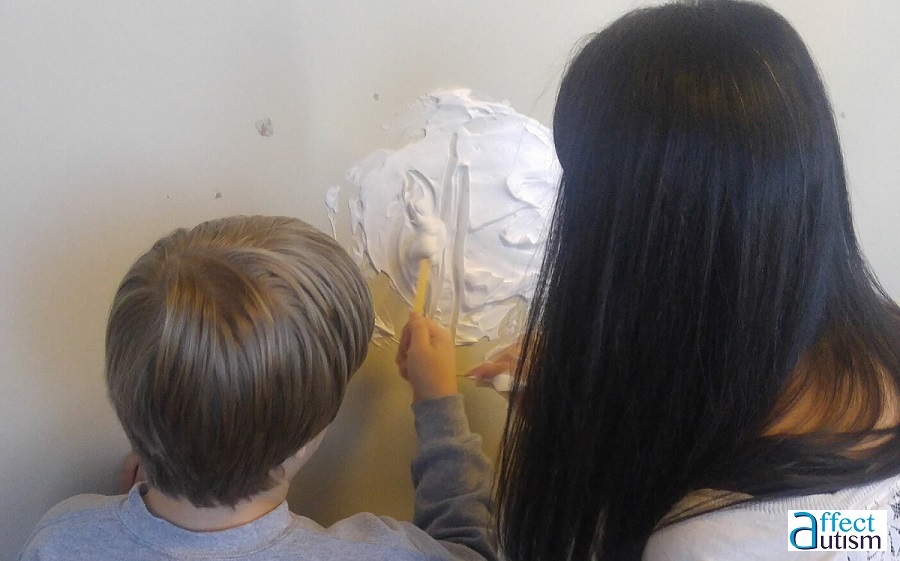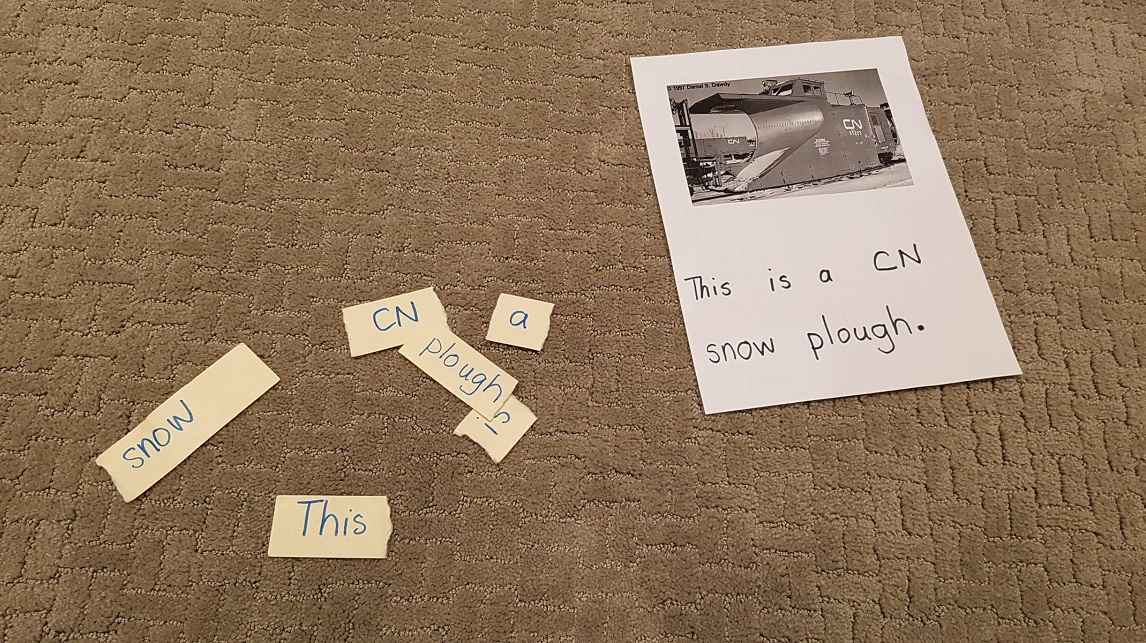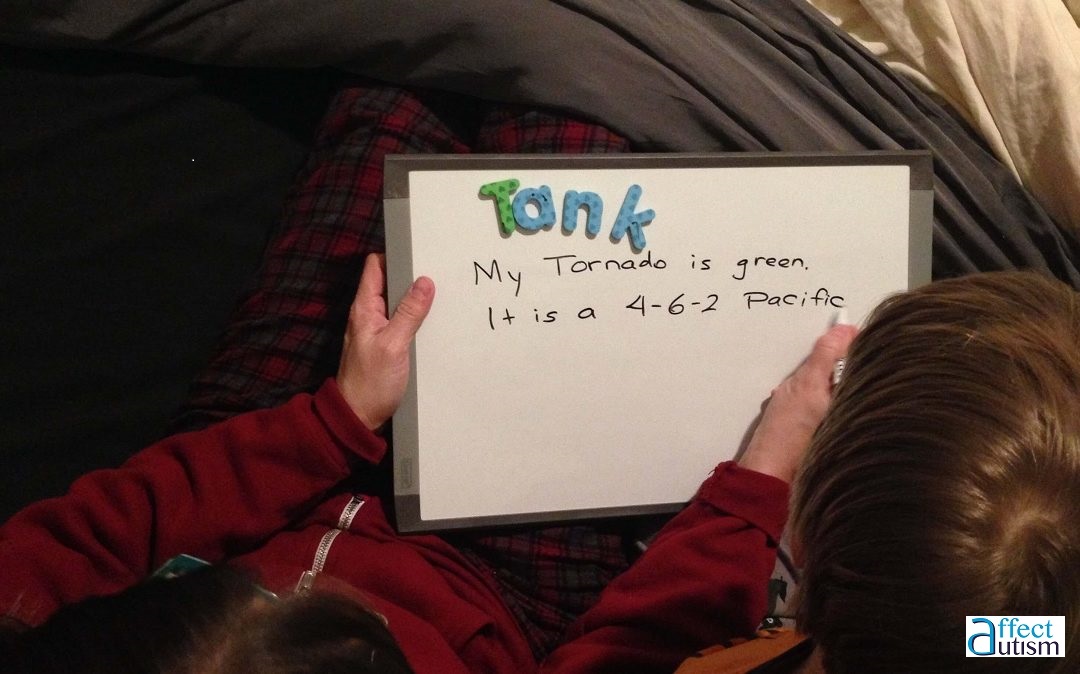Continuing with our spotlight on early literacy, we follow up from last month with our updates and next session with our early literacy expert. The last week of each month, we’ll cover our progress teaching our son about reading and writing using Reading Recovery as our model, a developmental approach that focuses on individualized programming within a one-on-one relationship.
On January 15th we received word from school that they worked on hand-over-hand printing with markers and on distinguishing between long and short lines in the letter ‘A’. In the photo, you can see our son at school with his occupational therapist drawing lines in shaving cream on the wall.

Tips from our early literacy expert
We showed him a picture and asked what it is. He said, “It’s a CN snow plough” so the early literacy expert wrote down “This is a CN snow plough.” I went to read it with him and he grabbed my hand and pointed to the words rather than pointing himself. She said this is fine. She said I was scaffolding the process for him. Eventually we want him to point on his own to each word so he has to fixate on the scribbles one at a time.

Make his own Little Books
- Make little simple stories that he knows. Using kids’ names is a great way to start with actions in the little books. We’ll get the most from him by making books for him about what he’s interested in.
- Knowing that his name is the most powerful thing for his memory right now, we can expect that he’s going to learn to locate that in print so a sentence that starts with his name helps him learn where a sentence starts.
- Next mix it up a bit by turning it into a locating activity. For example, “Jimmy is jumping. Where is Jimmy?” By putting a familiar name at beginning and end, it challenges the mind and eye to do something different. Also by changing the names you use from his to his friends’ names, he has to look to see if it’s his name or someone else’s.
- Things that are familiar for him are going to apprentice his eyes in the looking task but the focusing piece is going to be language. “This is a…. ” When you read something is he going to expect it’s permanent? It’s always going to say the same thing so you have to say what is written right there. It’s conceptual. Getting him to do it in the direction of print is the trickiest step of all.
- Know his language pattern. Don’t write “This is a ____” if he never speaks like that. Follow his natural language structure.
- Make books by having a bunch of cut-out pictures and let him choose what to put in the book. The key is to make it interactive. When you’re writing the words in the book, make sure he is seeing what you’re writing and is engaged.
- Engage him to do only whatever you think he can. It can’t take a lot of time. He has a short attention span. In terms of teachers doing this at school, it has to be the play work otherwise it gets long and laborious and the child’s like “Get me out of here!” Don’t bother with the cutting out the picture and making of the book itself. We are only focusing on creating the story together.
Writing
See if he starts to do the motions of writing letters. See if you can make headway with using a marker and doing it on paper.
- Think about the motions of lines and circles. For instance, for the letter ‘L’ you might say “down across“.
- Use a laser pointer to write letters on the wall or ceiling.
I tried something else at bedtime. I started spelling the names of trains on him. He will suggest, “Tornado” so I draw the ‘T’ then the ‘o’, etc. on his body: his forehead, the top of his head, on his tummy, or along his arm. He laughs when I get to the ticklish spots with the cutest belly giggle ever! I love that we’re making literacy fun.

He also has been asking us multiple times per day about a word: “What starts with (word)?” and “What ends with (same word)?” eager to know the first and last letter of the said word, whether it be a friend’s name, an object such as a toy, food or drink, or an item of clothing. He also guesses before we can give him a response, so he’ll say “b…n…a” almost randomly suggesting letters.
We encourage him to sound it out. So if he asks about “banana” we’ll say “b…b…b…ba-na-na” and he’ll reply, “b“. In the car on the drive home from school I also heard him reciting a song they sing at school: “Apple… a…a…apple; Boat… b…b…boat….Elephant…e…e…elephant” so by encouraging him to sound out the word, I was drawing on his experience doing that with the song at school.
Until next week… here’s to affecting autism through playful interactions!




Thanks! This gives me a lot of ideas!